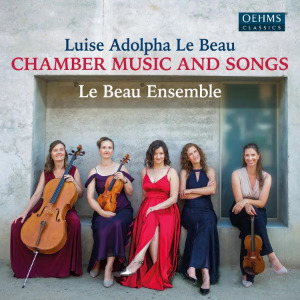
Luise Adolpha Le Beau (1850-1927)
Chamber Music and Songs
Le Beau Ensemble
rec. 2024, Alte Kirche Fautenbach, Achern, Germany
Oehms Classics OC1732 [60]
For musicians, one of the positives of the MeToo movement may be the discovery of many overlooked women composers of the past and indeed the present. Consider Rita Strohl, Charlotte Sohy, Alice Mary Smith – and Luise Adolpha Le Beau. Much of her music was published in her lifetime, so she must have been well respected.
Song cycles are a big part of Le Beau’s opus list. She had been a piano pupil of Clara Schumann. In some of the songs here, especially Op.4 and Op.18, one can hear touches of Robert Schumann. I do not know Clara Schumann’s Lieder well enough to comment on her influence on her student.
It is a disappointment that no texts have been provided. The booklet notes sometimes give us a general background of these songs, and we know the poets. Even so, I’m afraid that my German is not up to helping much. With unfamiliar music and indeed texts, this sad omission detracts from one’s enjoyment and understanding.
The early songs, Op.4 (written in 1865 when Le Beau was a pupil of Wilhelm Kalliwoda (1827-1893) and Op.11 are still immature in mood, and perhaps lack the desired depth of feeling. By the time of Op.39 and Op.45, there is more sense of inner penetration of emotion, and the colours of the voice come across better. Especially impressive is Wie dir, so mir (As you so am I), the first of Op.45. An unusually lengthy introduction on the violin and piano sets a serious mood for this reflective poem. Also remarkable is Erinnerung (Remembrance), the first of Op.39. Poet Rudolf Gernss seems to have regularly sent Le Beau his poems, so she obviously found something in them to inspire her creativity.
Speaking of the texts, a dozen authors are represented here, among them Joseph von Eichendorff (Der stille Grund) and composer and writer Peter Cornelius (Ich habe die Blumen so gern). Most of the others seem forgotten.
The Piano Quartet plays for almost half an hour. Let us pull no punches: this is a very fine work. One may feel the shadow of the Schumanns lingering over it, but more particularly the spirit of Mendelssohn. There is a serious opening Adagio before the Allegro con fuoco in sonata form opens out. The beautiful second movement, also an Adagio, is of similar length. The great novelty is Tempo di Mazurka – Intermezzo, with its more lyrical central section. The Allegro finale summarises the work by re-introducing ideas from elsewhere. This recalls Mendelssohn’s String Quartet Op.13 with – to quote Dr. Ulrike Keil’s useful booklet essay (thanks!) – its ‘cyclical linking of movement in the finale’.
This disc has pushed me into finding more of the music of Luise Le Beau, especially as the pieces here, mostly early works, probably presage greater things to come.
Now, the performances. Mezzo-soprano Nadia Steinhardt’s voice sometimes seems a little too heavy for the shorter, lighter songs. She is generally an ideal recitalist for this repertoire, and can sing with great passion and understanding. The Le Beau ensemble capture and convey the character and mood of the quartet eloquently. They appear to be inside Le Beau’s sometimes elusive language, with suitable bravura and polish.
Worth investigating.
Gary Higginson
Buying this recording via a link below generates revenue for MWI, which helps the site remain free



Contents
Five Songs Op.11
Five Songs Op.4
Three Songs for alto, violin and piano Op.45
Three Songs Op.18
Three Songs Op.39
Piano Quartet in F minor Op.28
Performers
Nadia Steinhardt (mezzo-soprano)
Henrike von Heimburg (piano)
Ruth Gierton-Holingshaus (violin)
Liese Mészár (viola)
Trude Mészár (cello)

















